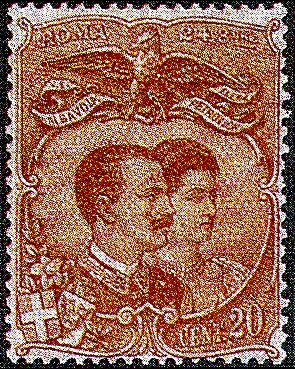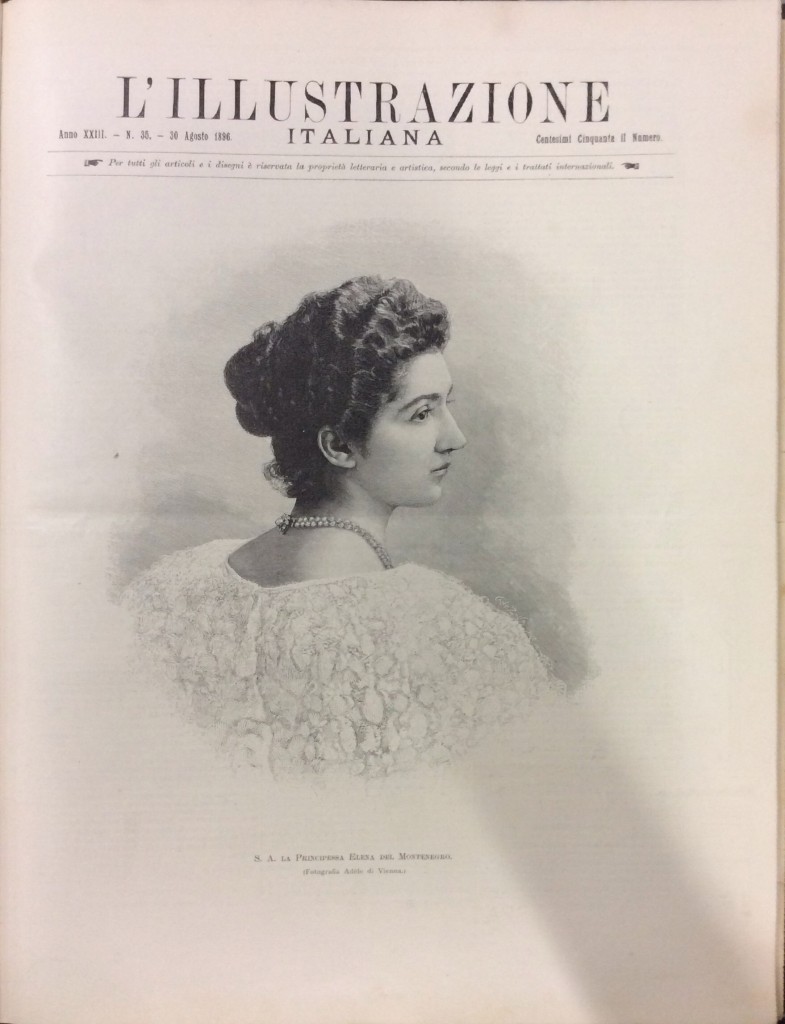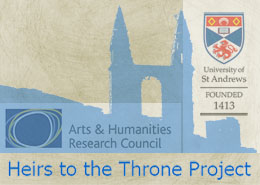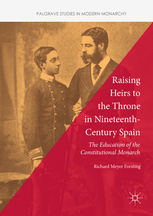A Fairytale Union?
Maria-Christina Marchi
His Highness the Prince of Naples cuts a fine figure, it is a shame that the fact that his legs are so short takes away from that martial aspect that is so desirable in a crown prince. He is cultured and he is serious beyond his years. He looks promising…
Paolo Paulucci, Diario Segreto
Unlike his parents, Vittorio Emanuele III (1869-1947) shied away from the limelight. His years waiting for the throne saw him fulfil his duties in a much more restrained manner than that which had characterized his parents’ time as heirs apparent. During his early years his governor, Colonel Osio, kept the young Prince immersed in his studies and military life, rejecting many invitations to parties and unofficial ceremonies that were sent to his student. Moreover, the young Prince did not engage in the same activities for which his father was famous – he did not share the same passion for horse riding, or the same penchant for philandering. Much less interested in the monarchy’s public role, the young prince grew up in a strict and generally private manner.
In 1891 however, when the Prince of Naples was twenty-two, Minister-President Francesco Crispi supposedly approached Queen Margherita about the young man’s future. He was of marrying age and a marriage would mean a new political and dynastic alliance for Italy, which might help the country gain some prestige on the European stage. According to Domenico Farini, President of the Italian Senate from 1887 to 1898, Crispi already had a suitable candidate in mind: one of the princesses of Montenegro. Other candidates came up as well, such as the daughter of the Duke of Edinburgh – however her unwillingness to convert to Catholicism immediately excluded her from consideration. In light of this initial failure to secure the prince a bride, Margherita, sensing her son’s lack of interest in marriage at that point, believed that decision to select a spouse for her son would be a little premature.
The prince thus remained a bachelor for five more years. His unimpressive stature did not add to his desirability, and although Queen Victoria described him as “wonderfully well-informed, intelligent and amiable” and wrote to Umberto that she had been “charmed” by the young man, he did not seem to charm any of the ladies or princesses he encountered. As early as 1893 rumours began to circulate that the prince was actually impotent, which would help explain why there were no affairs. Giuseppe Saredo, who had been the commissioner of Naples during the prince’s residence there, was convinced that this could indeed be possible. The rumours were further fuelled by the prince’s cousin’s marriage. Emanuele Filiberto, Duke of Aosta, wed Princess Hélène of Orlèans on 25 June 1895 in Kingston Upon Thames. The Duke, who was the first born child of Vittorio Emanuele’s uncle, Prince Amedeo, and had been Prince of Asturias, heir to the Spanish throne, for three short years as an infant, posed a serious threat to the throne – if the rumours were true the throne would eventually pass on to him. He was much more attractive than Vittorio Emanuele, and unlike his royal cousin, looked dashing in military uniform. Queen Victoria described him as a “tall and good-looking man” and his popularity soared during the First World War where he became known as the Duca Invitto, the Undefeated Duke.
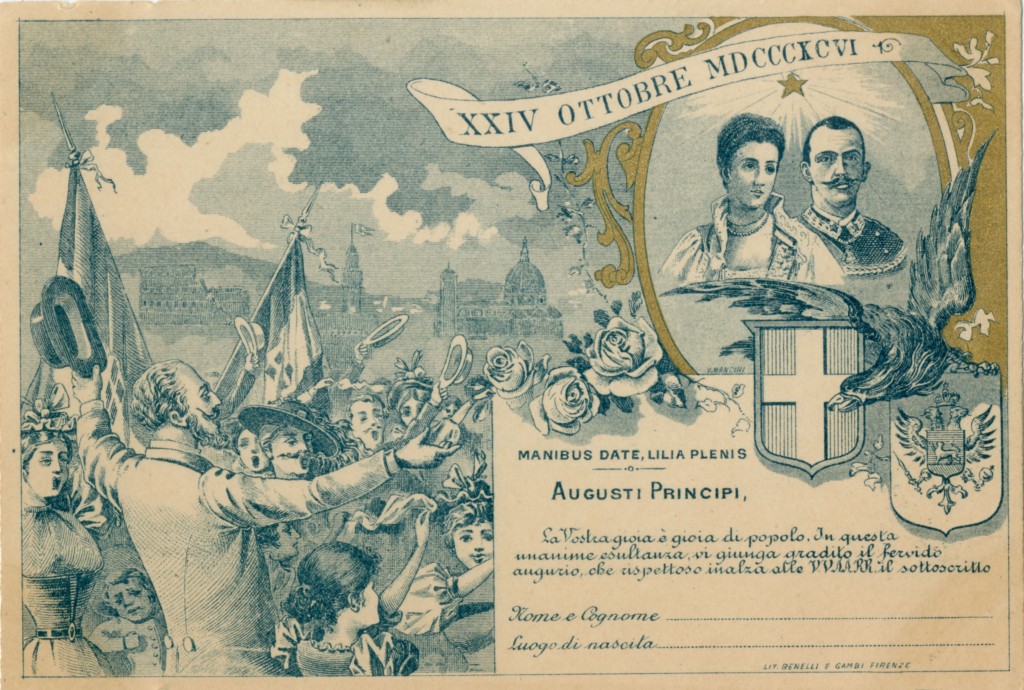
Special Edition Postcard for the Savoia-Petrovich Royal Wedding (Archivio del Risorgimento di Bologna)
There was no cause for concern, though, for the future king of Italy proved to not be impotent. The Minister of the Royal Household, Rattazzi, told Farini that it could not be true for “in Naples [the Prince] would spend many nights away from home” and that he had been put under surveillance, helping his staff to determine that he was in fact spending his nights visiting a female member of the Neapolitan aristocracy. However, the rumours could not be wholly quashed until the Prince took a wife. Thus, the mission to find the Prince a suitable spouse resumed.
In the spring of 1895 the International Exhibition of Art was inaugurated in Venice. The king and queen, accompanied by the heir, were welcomed by “an enormous, applauding crowd and by a multitude of lavishly decorated gondolas. The entire Canal Grande was full of flags and the balconies of the sumptuous palaces, all of their windows, were overcrowded with ladies… it was a magical scene.” This magnificent stage set up the performance that was to follow. In fact in the days following the Savoias’ arrival in Venice the royals were visited by the Princess of Montenegro and her “splendid daughters”, one of whom was the Princess Elena Petrovich (1873-1952), the future queen of Italy. The ladies were introduced to the sovereigns and Elena was placed next to Margherita at one of the banquets. She also met Vittorio Emanuele, however this initial introduction did not arouse any suspicions on the prince’s part. He did not realise that there was an ulterior purpose to this introduction – it created the possibility for his royal parents to lay eyes on a possible candidate.
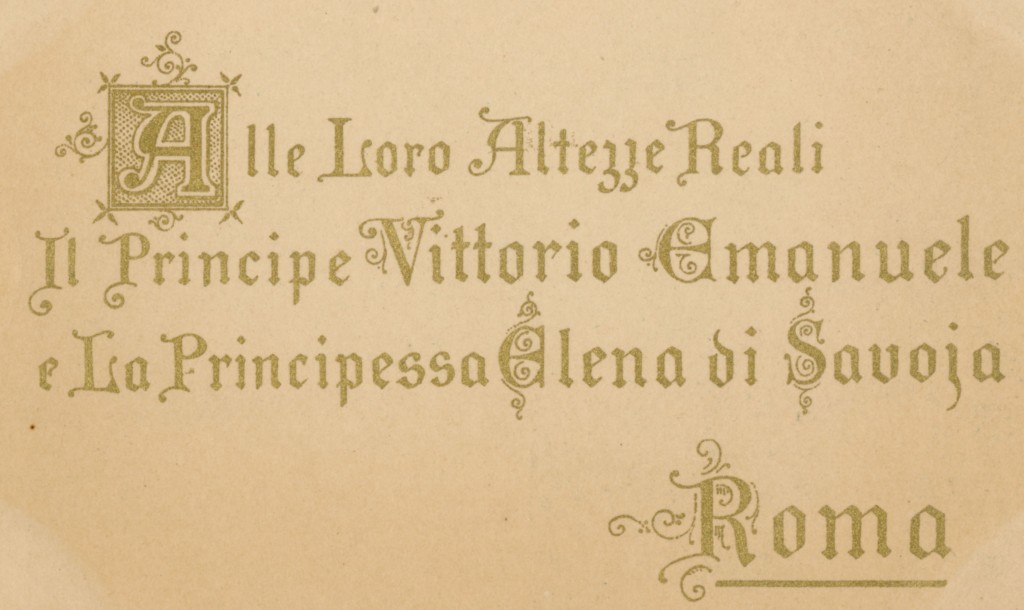
The back of the above postcard reads: “To their royal highnesses the Prince Vittorio Emanuele and Princess Elena of Savoia.”
It was not until he was sent to Russia as the Italian representative at Tsar Nicolas II’s coronation that Elena struck him as the ideal wife. The coronation took place in May 1896 and by June King Umberto had sent the Italian ambassador in Vienna, Costantino Nigra, a telegram asking him to enquire whether or not Elena’s father, Nicola of Montenegro, who was in Vienna at the time, would look favourably on a match with the House of Savoia. Umberto wrote: “[when] the Prince of Naples [was in] in Moscow [he] found Princess Elena of Montenegro very pleasant and desires to marry her. Queen and I approve of this marital plan.” He asked the ambassador to make sure that the princess would be willing to convert to Catholicism – an absolute prerequisite for her to be able to accept this proposal. Less than 24 hours later Nigra replied confirming Nicola’s interest in the match.
On 18 August 1896 the betrothal of the prince and princess was officially announced in both Rome and Cetinje. The Prince of Naples had travelled to Montenegro in order to ask for Elena’s hand in marriage and the trip had served to formalise the ties between the two countries as well as between the two dynasties. Elena was described by the Italian press as a “marvellous princess, with opulent black hair, dazzling black eyes, a slender frame, and of oriental beauty.” What was stressed in particular was the fact that this was not a marriage of convenience, not one arranged in order to create an alliance for the Italian state, but rather a marriage of love and “a homage to beauty.” This narrative allowed the engagement to acquire a fairy tale-like status. In the popular Illustrazione Italiana it was reported that as soon as the Prince of Naples had returned to Rome from Moscow he had declared that he would either marry Elena or not marry at all. This romantic impetuousness had given the prince a stronger, manlier image, which helped him appeal more widely to the Italian people.
The belief that this was in fact a marriage of love was perpetuated by the prince himself, who was convinced that he had picked his bride all by himself, without being part of any political web. As soon as his betrothal had been made public, he wrote to his former governor and friend Colonel Osio announcing the engagement. In response to Osio’s congratulations the prince declared: “…the part that you have played in these celebrations makes me infinitely happy; I did everything on my own accord and without any help from politics, which is fortunately a thousand miles away from my engagement…” His mother, Queen Margherita, maintained the same conviction, even though her role behind the scenes – selecting a suitable bride and accepting Elena as her future daughter-in-law – had been anything but negligible.
My dear Osio, she wrote, I am very pleased! I am so happy about my son’s engagement, so happy that I cannot believe that one can feel so alive after having passed the 40-year mark. He actually chose his own bride… When he came back from Russia after 20 days spent in Princess Elena’s company, he told us that he wanted to marry her, that he would not marry anyone else! We were so happy! …
They say the best things about our future daughter; I have seen that she is beautiful, healthy, elegant, vivacious and pleasant, and from reliable sources I have heard that she is good, full of character and of courage, intelligent and very well educated. She comes from a good and virtuous race, from a very respectable and united family, and from a morally and physically healthy people, brave and loyal, a nation of soldiers…
Margherita, 29 August 1896.
P. S. I am so happy that the news of the wedding has been so well received in Italy. This wedding of true feelings with a princess of a nation of such valorous people appeals to the public!
Once again the queen’s preoccupation was how royal actions were perceived. The political situation in 1896 was not particularly stable, and both government and crown had been involved in the military fiasco in Ethiopia. The defeat of an Italian army in the battle of Adwa in March 1896 had secured Ethiopian sovereignty, and the crushing of Italian troops by African warriors threatened internal political stability in Italy. Francesco Crispi had believed that a “baptism of blood” would have been the best solution for generating a cohesive national identity. An article in La Riforma, a left wing newspaper founded by Crispi in the 1860s, depicted the mission in Africa as one of national importance, for “thanks to [the heroes of Africa], the old wish, too often made a mockery of since 1860, can now be said to have been fulfilled. With pride, we can now claim that not only Italy, but also Italians, have been made!” However, the pursuit of colonial power in Africa had resulted in a crippling defeat. Alessandro Guiccioli, the prefect of Rome at the time, wrote in his diary that this was a “catastrophe… a total disaster…” and marked it as “the loss of [Italian] honour.” In addition to the failure of the military, Italy was in the midst of a financial crisis. The crown had been involved in a large banking scandal and martial law had been declared in Sicily as a result of growing popular agitation. The unhappy situation was causing mass dejection and little faith could be placed in the governing bodies.
Therefore, the wedding could not come at a more opportune moment. With the crown struggling to find support, it was an opportunity to draw attention to its more positive facets: the prince’s love story and the brighter future that the newly engaged couple represented.
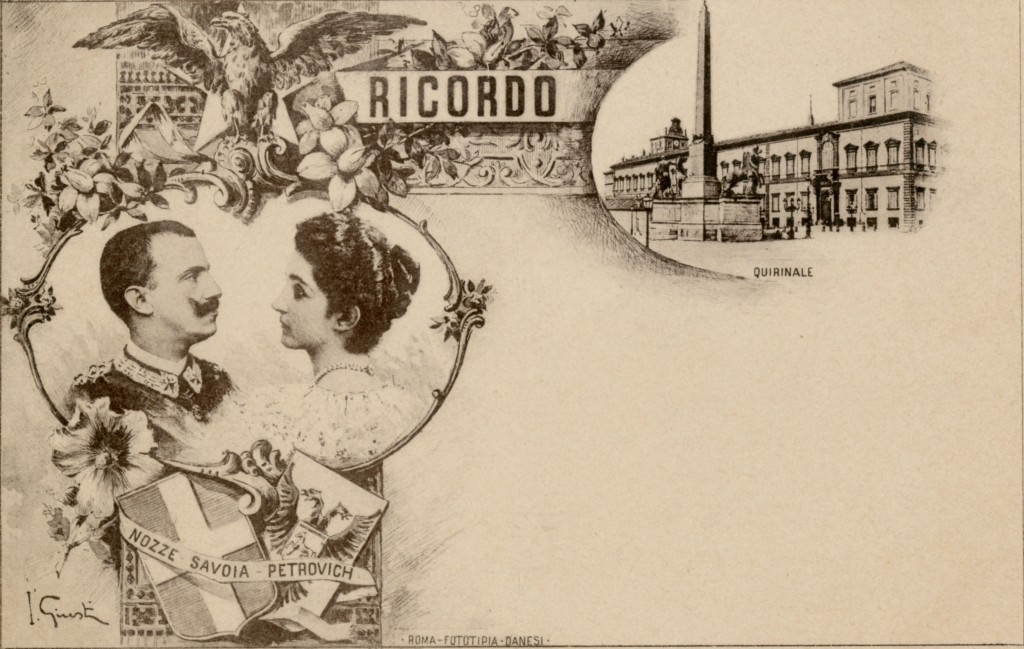
Another commemorative postcard to celebrate the royal wedding (Archivio del Risorgimento di Bologna)
After the engagement was announced Elena and her native Montenegro took centre stage in the national press. Distracting from the dispiriting events of 1896, the attention was shifted onto this soon to be member of the nation. Books were published on Montenegro’s people and history, and volumes were printed presenting Elena to the Italian public. The Princes’ journey towards Italy, closely followed by the press, was celebrated as an opportunity of redemption following the tragedies that had marked the previous months.
However, another opposing force, which was problematic for the monarchy, was the Church. Its involvement in the celebrations was troubling. Ever since the ex-communication of the Savoia monarchy in 1871 and the Vatican’s refusal to recognise the legitimacy of the Italian state, Crown and Church had been vying for power over the hearts and minds of the Italian people. The Church seemed to be the frontrunner in 1896, and it had managed to entrench its power so as to make the royal nuptials as difficult as possible: “the curia has won again. No Basilica, no roman ecclesiastical presence, no cardinal, no monsignor Anzino [the monarchy’s trusted priest], no orthodox wedding for Montenegro to be later converted into a Catholic one…” Farina made it clear that the monarchy’s attempt to regain public favour was not as easy as they had hoped. When Elena disembarked in Bari, she had to renounce her faith immediately and become a Catholic. Her dejected attitude during the mass in Bari, where this was made official, demonstrated the unhappiness this request was causing her. Margherita had insisted on this as a condition, though, in order to demonstrate the dynasty’s loyalty to Catholicism, but the Church had determined further that Elena could not set foot in Rome unless she had converted already. Consequently, the plan for her to become a Catholic after the wedding fell through and the monarchy was obligated to bend to the Church’s will.
Thus, the fairytale engagement acted as a screen, veiling the disputes and tensions from the public eye. The wedding itself on 24 October 1896 was not as widely publicised as Umberto and Margherita’s nuptials, and due to the costs of the war effort the celebrations were not as lavish either. However, the engagement had served to lift national spirits and bring the crown back into a more positive limelight. The focus on the wedding as one based on love was a powerful tool to add a touch of romanticism to the crown and perhaps bring the people to rediscover their own love for the monarchy. And although the nuptials did not redeem the monarchy and government’s past actions it still drew crowds to Rome and allowed, if only for a brief moment, for the nation to come together to celebrate the union of the Prince and Princess of Naples.
Suggested Further Reading:
- Alessandro Guiccioli, Diario di un Conservatore, (Milano: Edizione del Borghese, 1973)
- Domenico Farini, Diario di Fine Secolo, (Roma: Bardi, 1961)
- Silvio Bertoldi, Vittorio Emanuele III: Un re tra le due guerre e il fascismo, (Torino: UTET, 2002)
- Denis Mack Smith, Italy and its Monarchy, (New Haven: Yale University Press, 1989)

